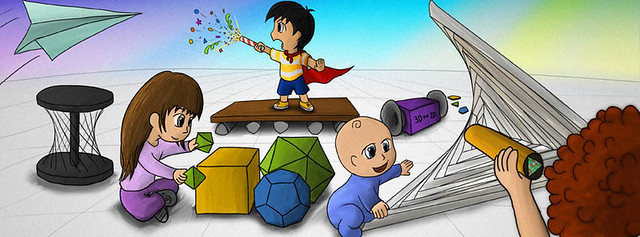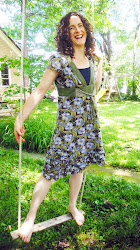Marie: Leading Math Circles at 10?

My name is Marie, and I am ten years old. Since I was six years old, I have attended a math circle. Last year I started to help out with the class for little kids. This year, I decided that I could start teaching a math circle on my own. Now, I am teaching a Pre-K math circle for little kids that are about four or five years old. The kids are used to me now, and I am really enjoying the teaching experience.
This is what I observed during one of the classes; it’s very funny. When I told the kids that the problem they were solving was a game, even if it was a just an ordinary problem, the kids started getting much more involved in it, because they thought that they weren’t actually solving a problem, but that they were playing a game! An example of when this happened was when we were using the board and pieces of the game, “Othello” (we weren’t actually playing the game though). The kids were reluctantly solving geometric problems using Othello pieces, until I told them that we were playing a game. “A game? Let’s play!” yelled the kids, excitedly going back to the exact same problems they were solving before.
Kids are much more involved in the class when:
- The problems involve them
- They get to choose what the problems are about, or at least change the details of the problems
- The problems involve real-life situations, especially if they have to do with their life
- The problem has a fairy tale, or some other kind of story woven into it.
For example, when the class was doing Venn diagrams, I made the diagrams about who in the class had sisters, brothers, or both. The kids were delighted with the very idea that they would be inside a mathematical problem!
I observed that warm-ups and easy problems that kids can solve on their own, correctly, help the kids relax and build more confidence in themselves, when encountering harder problems later in the lesson. Discussions and introductory examples to the topic are a good way to start a lesson. DO NOT start a lesson with a game! Kids will lose their attention, become over-excited, and be unable to return to the topic.
Teaching a math circle turned out being much more fun and interesting than I expected. I enjoy listening to the kids’ ideas and thoughts, and observing how they react. The kids consider me adult enough that they listen to me, but they see that I am still a child, so they are not afraid to share their ideas, and make mistakes.
If you would like to see the lessons of the math circle, and more details, please visit my blog at:
http://trickyprekmath.blogspot.com/
Thank you.
Posted in Grow
Math Goggles #3 – Ch-ch-chain… of Attributes
Have you ever played a rhyming game? If not, join me for this week’s Math Goggles challenge. If you are new to Math Goggles and not sure what to do and why do it, check out this page first.

The inspiration for this week’s game comes from Malke Rosenfeld who sent me the I Spy in Common board game. The game has lots of tiles with seemingly unrelated pictures on them. That is, unrelated, until you start thinking creatively and finding common attributes on the different tiles.
We are going to play a grown-up version of this terrific game and we won’t need game tiles either. Here’s how – look around the room and choose any object. Now, look around some more and choose another object that shares at least one common attribute with the first object. Next, look for object #3 that has something in common with the object #2. And so on. How many objects can you chain together? For an extra challenge, can you loop back to the object you started with without repeating the attributes?
Here’s what my living room ch-ch-chain looks like:
My phone has lots of buttons and so does my…
… which is also rectangular in shape, just like…
… the bricks on my fireplace which, as you can see, are laid in a very simple pattern that reminds me of…
… this old wooden typeset drawer which is on the wall next to the fireplace and opposite…
this wooden bowl. This is the first non-rectangular object in my chain, so I’m going to add my…
… this round chair that sits next to it. The chair is made of woven rattan…
… which is different from the bamboo used in the blinds except that they are also woven. And you see this thin cord for pulling the blinds up? It brings me back to…
… my laptop and all the cords sticking out of it. And guess what? Since my ThinkPad is black, it shares that in common with… drum roll…
… my phone! (both the buttons and the plastic back)
Ok, so maybe my pictures aren’t all that inspiring (naturally, I blame it on my cheap point-and-shoot camera). In which case, check out the Rhyming Pics project archives (unfortunately, the project is no longer active) for some beautiful pictures. Can you follow the chains and guess the shared attributes in those images?
If you play this game and post it to your blog, Flickr!, Facebook, etc, let me know in the comments.
Posted in Grow
Newsletter January 30, 2013

Welcome to adventurous math for the playground crowd! I am Moby Snoodles, and I love to hear from you at moby@moebiusnoodles.com
Book news
We are getting the last reviews in from the volunteer reviewers group that had a go before copy editing. I am so happy to get cheers and kudos from respected colleagues in parenting and mathematics! It’s one thing for me to think our team did a good job; it’s another level of happiness entirely to see what others love about the book.
Blogs and networks
We have been making good friends in the Creative Commons crowd, who change the world one open-source program, video or book at a time. We joined the big worldwide celebration of the ten years of the Creative Commons. This is the video of our talk:

Exciting news! Malke Rosenfeld, the creator of the Math In Your Feet program and a math explorer at The Map Is Not the Territory blog, is joining our team. In her first book review called “Hidden math” Malke goes on a scavenger hunt for ideas such as frieze patterns and parallel lines – in books that aren’t math readers! Malke asks: “What other books are out there that have this kind of ‘hidden’ math?” Have you seen any?

Yelena McManaman adds another gem to my growing collection of hundred charts. Check out her post on why this version works well for young kids.
Have you noticed my new fancy steampunk eyewear and a camera? That’s because we started a series of posts called Math Goggles! If you like field trips, you will love these scavenger hunt adventures. Check out the first one, at the high-tech library at NCSU.
Sharing
You are welcome to share the contents of this newsletter online or in print. You can also remix and tweak anything here as you wish, as long as you share your creations on the same terms. Please credit MoebiusNoodles.com
More formally, we distribute all Moebius Noodles content under the Creative Commons Attribution-NonCommercial-ShareAlike license: CC BY-NC-SA
Talk to you again on February 15th!
Moby Snoodles, aka Dr. Maria Droujkova
Posted in Newsletter
Math Goggles #2 – Home Patternomics
It’s time to put on the Math Goggles (not sure what these are? Head over here to find out). Last week I invited you to search for math at your local library. But this week I haven’t had much free time for impromptu field trips. So I’m donning my goggles and hunting for math around the house. To make things a bit more interesting, I decided to only look for one thing – patterns.
I found my first pattern walking down the stairs. Rise-run-spindle-spindle-rise-run-spindle-spindle… I only have one cat, so the pattern was broken there.
Next I had to put some books away and noticed this weaving pattern on a basket on my bookshelf.
And what about a bookshelf itself? Large shelf, two small shelves, large shelf, two small shelves. Moving to an even larger scale, the furniture arrangement pattern in the room (as noticed by my husband) is “furniture to sit on, furniture to pile books on, furniture to sit on, furniture to pile books on…“

But of all the patterns I found around the house today, this one had to be my favorite. I had to replace batteries in one of the toys and here it was, positive-negative-positive-negative terminals.
What patterns can you find in your house?
P.S. Once you start noticing patterns, it gets very addictive. So here’s a cool and very relaxing idea for a collaborative pattern hunt video I found on YouTube. Next time you have a few minutes to spare, doodle the patterns you notice. Here’re my doodles, including the furniture arrangement pattern, the stairs pattern (reflected and rotated), the batteries pattern and a few more.
Posted in Grow

















